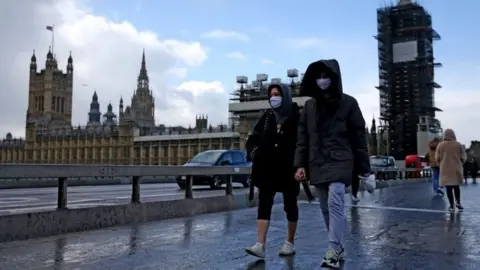Coronavirus: How feasible is a 'virtual Parliament'?
 Getty Images
Getty ImagesCommons Speaker Sir Lindsay Hoyle is calling on the government to allow a "virtual Parliament" so that MPs can take part in debates from home when the Commons returns to work, still expected later this month.
But would it work?
Legislators across the world are struggling to find a balance between scrutiny and safety, as they battle to find a way to keep working during the coronavirus pandemic.
None of the options are tried-and-tested - and any innovations will be improvised.
On a practical level, the UK's Parliament at Westminster, parts of which date back to the Middle Ages but which was rebuilt in the Victorian era, was not created for technological innovations.
'Decent wi-fi'
Both the Welsh and Scottish assemblies were completed in the 21st century, making them more suitable for video links and potential remote voting.
There are basic issues with connectivity. When Labour MP Chris Bryant was running to succeed Speaker John Bercow last year, he called for "decent wi-fi and mobile signal across the Parliamentary estate".
On Wednesday. the Welsh Assembly - or the Senedd - claimed to be the first major democratic institution in the UK to meet remotely.
Members used Zoom video conferencing to meet virtually from across Wales for the weekly plenary session, which usually takes place in Cardiff.
And the Tynwald, on the Isle of Man, which claims to be the world's oldest continually-sitting Parliament, has announced plans to go digital, due to coronavirus.
A new select committee has been created in New Zealand, which will be able to question ministers remotely during an extended recess.
The Electoral Reform Society says it is as an example of holding the government to account "in a way that has not happened in the daily press conferences" that have been held in Downing Street, during the coronavirus outbreak.
Voting lobbies
Other examples include the European Parliament, which trialled email voting in March. In Spain, there is already the infrastructure to allow remote voting, set up for politicians who are unable to attend.
Meanwhile, the Pennsylvania General Assembly has introduced remote voting for the first time.
Although there are growing calls for the same to happen nationwide in the US, leading figures such as Speaker of the House of Representatives Nancy Pelosi have raised concerns about the constitutional and security implications of setting up a system.
Similar objections have been raised whenever the issue of allowing MPs to vote remotely, via their smartphones or tablets, has been floated in the past.
At the moment, MPs can only pass new laws by queuing up in the voting lobbies behind the Commons chamber, which can get pretty crowded.
So any move to a "virtual Parliament" may be for the purposes of holding the government to account, through debates, ministerial questions, and Prime Minister's Questions, as well as select committee hearings, rather than passing legislation.
Uphill battle?
Another problems with implementing a new digital democracy in Westminster is a lack of resources and staff.
Before Parliament adjourned for recess on 25 March, Speaker Lindsay Hoyle said: "We do not have the staff to carry out a lot of things that we want to happen at this moment.
"They are with us during the Easter break and we will see what we can do."
His tone seems to have changed and the government sounds like it might be on board but, however hard officials work to create a new system, they are facing an uphill battle.
